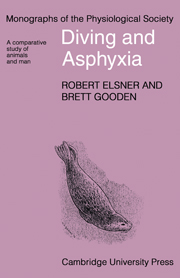1 - The biological setting
Published online by Cambridge University Press: 18 May 2010
Summary
The diving mammals offer the physiologist a natural experiment which shows how long and by means of what respiratory adjustment a mammal can endure asphyxia
(Laurence Irving, 1939).Depriving living organisms of oxygen and of the opportunity to rid themselves of carbon dioxide leads inevitably to progressive disruption of cellular biochemical processes, physiological dysfunction and the undoing of biological integrations which are collectively essential for homeostatic life. This condition, asphyxia, is a threat which lurks never far away from living vertebrate organisms. The so-called lower animals are generally more resistant to it than the higher, more complex forms which, for that complexity, are dependent upon a nearly continuous respiratory exchange. Asphyxia, and responses to it, can take several forms. It can characterize the disturbance of blocked respiration in a whole animal and it can take place in a regional tissue which is deprived of the perfusing blood required for the exchanges that are necessary for cellular survival. It is what the diving seal or duck experiences when it holds its breath and submerges in water. That exposure is usually brief and non-threatening, but if asphyxia continues without interruption, it leads inevitably to cellular disruption and organism death. In the considerations which follow, examples will be drawn from phenomena other than diving, and from both aquatic and terrestrial species, including man.
Resistance to asphyxia varies with species, age and special adaptation. Tolerance to ischaemia, the occlusion of blood flow, also varies within the animal according to the type of cells in the tissue deprived of circulation.
- Type
- Chapter
- Information
- Diving and AsphyxiaA Comparative Study of Animals and Man, pp. 1 - 13Publisher: Cambridge University PressPrint publication year: 1983
- 4
- Cited by

